Scratch Core Sample Sally Original Design / Scratch Built
Scratch - Core Sample Sally {Scratch}
Contributed by Jim Ballard
| Manufacturer: | Scratch |

Brief:
A 4" x 67" 3FNC rocket designed as my first attempt at dual
deployment. This rocket was also designed to be capable for a future L2
attempt.
Construction:
The parts list:
- 3 sections of LOC 4" body tubes (18", 16", and 21" long)
- 3 4" x 38mm LOC centering rings
- 2 7 1/4" long pieces of 1/4-20 all thread rod
- 1 14" x 38mm motor tube
- 3 3.9" x 1/4" LOC bulkheads
- 3 3.9" LOC couplers
- 1 4" LOC nose cone
- 3 3/16" plywood fins
- 1 30' tubular nylon recovery harness (drogue bay)
- 1 25' tubular nylon recovery harness (main bay)
- 2 Kevlar® cord protectors
- 2 Kevlar® chute protectors
- 1 Perfectflite MAWD altimeter
- Homemade parachute
Construction is very straight forward and anyone with experience building one or two high power models shouldn't have any problem building this one. All of the materials used in construction are readily available from LOC. I used an 18" section of LOC tubing for the booster section where I incorporated Stu Barett's anti-zipper design. Fin and motor mount construction are typical for HPR with the fins being attached with epoxy through the airframe wall to the motor mount. A rotary tool was used to cut the slots after marking the locations on my homemade fin jig. Don't forget the add your favorite form of motor retention and plan for it before construction begins. I use the Kaplow Klip method, it has worked well for me.
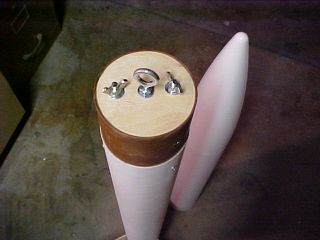 Anti-zipper detail: A 4" x 6" coupler was used on the forward end of
the booster to create the anti-zipper coupler. I made this coupler a little
stronger by adding a second coupler on the inside. This was accomplished by
cutting a longitudinal line through the coupler and sliding it inside of the
other coupler, letting the cut ends overlap and simply cutting off the
overlapping material. 1/4" was then cut from one end of the "smaller
coupler" and epoxied inside, with the aft end of both couplers being
flush. This gives a 1/4" clearance on the forward end for a bulkhead
plate. Once the bulkhead was epoxied in and a 1/4" eyebolt was installed
using JB Weld to secure the nut on the backside, this beefed up coupler
assembly was epoxied halfway into the forward end of the booster section. This
completes the hardest part of construction.
Anti-zipper detail: A 4" x 6" coupler was used on the forward end of
the booster to create the anti-zipper coupler. I made this coupler a little
stronger by adding a second coupler on the inside. This was accomplished by
cutting a longitudinal line through the coupler and sliding it inside of the
other coupler, letting the cut ends overlap and simply cutting off the
overlapping material. 1/4" was then cut from one end of the "smaller
coupler" and epoxied inside, with the aft end of both couplers being
flush. This gives a 1/4" clearance on the forward end for a bulkhead
plate. Once the bulkhead was epoxied in and a 1/4" eyebolt was installed
using JB Weld to secure the nut on the backside, this beefed up coupler
assembly was epoxied halfway into the forward end of the booster section. This
completes the hardest part of construction.
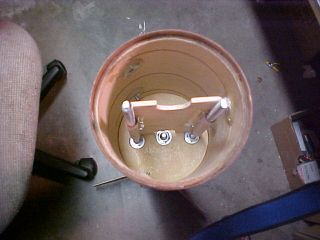 You
can use one of the 4" altimeter bay kits on the market or you can simply
build your own as I did out of an LOC 4" coupler and "Stiffy"
tube also available from LOC. If you build your own, I highly recommend the
stiffy tube as it really makes the coupler very strong. I used two 7 1/4"
lengths of 1/4" all thread to hold the altimeter bulkheads together, and
1/4"-20 eyebolts for recovery harness attachment. I used 3 evenly spaced
T-nuts epoxied inside the altimeter bay 1 1/2" from each end to secure the
drogue and main body tubes to the bay. The altimeter sled was made from
1/8" plywood with 1/4" cardboard lugs so it can be easily removed.
You
can use one of the 4" altimeter bay kits on the market or you can simply
build your own as I did out of an LOC 4" coupler and "Stiffy"
tube also available from LOC. If you build your own, I highly recommend the
stiffy tube as it really makes the coupler very strong. I used two 7 1/4"
lengths of 1/4" all thread to hold the altimeter bulkheads together, and
1/4"-20 eyebolts for recovery harness attachment. I used 3 evenly spaced
T-nuts epoxied inside the altimeter bay 1 1/2" from each end to secure the
drogue and main body tubes to the bay. The altimeter sled was made from
1/8" plywood with 1/4" cardboard lugs so it can be easily removed.
The drogue section is a 16" section of 4" LOC body tube secured to the aft end of the altimeter bay. The main section is a 21" section of 4" LOC body tube secured to the forward end of the altimeter bay.
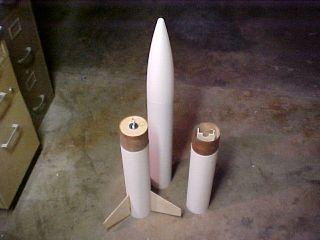 The
nose cone is held in place using 3 equally spaced 2-56 nylon screws as shear
pins. These are located 2" from the forward end of main bay tube. After
drilling the holes in the body tubes, I soaked these holes very well with CA to
harden them up and help keep them from becoming elongated with use. On the nose
cone I used 3 pieces of .010" thick stainless steel sheet slightly
recessed and epoxied into the shoulder of the nose cone to create a
"knife" to help make a clean cut on the shear pins during main
deployment.
The
nose cone is held in place using 3 equally spaced 2-56 nylon screws as shear
pins. These are located 2" from the forward end of main bay tube. After
drilling the holes in the body tubes, I soaked these holes very well with CA to
harden them up and help keep them from becoming elongated with use. On the nose
cone I used 3 pieces of .010" thick stainless steel sheet slightly
recessed and epoxied into the shoulder of the nose cone to create a
"knife" to help make a clean cut on the shear pins during main
deployment.
I used a Perfectflite MAWD altimeter to handle the recovery duties. I have been very pleased with its performance.
Finishing:
The finish on this rocket is nothing to write home about. I used 3 coats of
Kilz white primer (allowing 24hrs between coats) and 3 coats of Krylon red,
gray, and yellow.
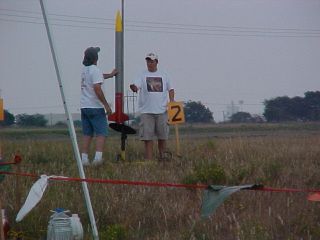
Flight:
The first flight took place at McGregor, TX in September 2004 at a DARS launch.
As expected, I was quite apprehensive as I began the prep, but I felt my way
along doing my best to check myself as I went along. The Cesaroni I205 was
loaded after removing the ejection charge and it was off to the pad. The
Perfectflite MAWD powered up and signaled continuity to the ejection charges.
Nothing to do now but watch it fly.
The CTI I205 came up to pressure quickly and up she went with a slight bit of weathercocking in about 10mph winds. The MAWD was beeping out 1697', only 3 feet short of the predicted max altitude. Awesome Flight! She flew again the following day and a third time in October 2004 at Wayside, TX with the POTROCS club for another pair of successful flight.
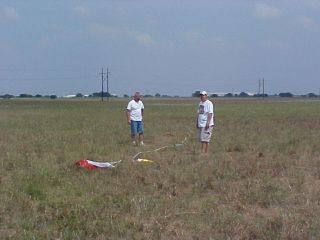
Recovery:
The booster and drogue section separated at apogee perfectly and the rocket
began its trip down to main deployment altitude on a 10' homemade streamer.
Right on cue, the MAWD fired the main charge at 500' and deployed my homemade
main chute. I started breathing again. Core Sample Sally was recovered about
100yds south of the pads without a scratch.
Summary:
A lot of PROs here. This rocket was built for the purpose of giving me some
experience with dual deployment and it has doing this very well so far.
Construction was straight forward with no major "gotchas".
I can't think of any CONs.
 |
 |